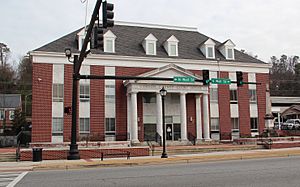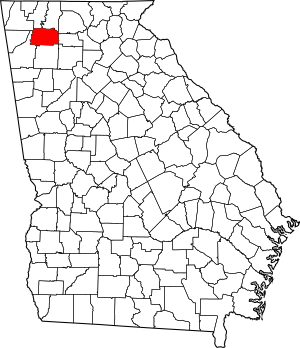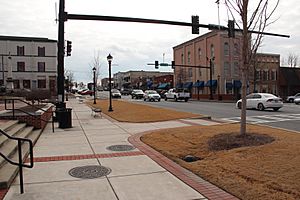Gordon County, Georgia facts for kids
Quick facts for kids
Gordon County
|
|
|---|---|

Gordon County Courthouse
|
|

Location within the U.S. state of Georgia
|
|
 Georgia's location within the U.S. |
|
| Country | |
| State | |
| Founded | February 13, 1850 |
| Named for | William Washington Gordon |
| Seat | Calhoun |
| Largest city | Calhoun |
| Area | |
| • Total | 358 sq mi (930 km2) |
| • Land | 356 sq mi (920 km2) |
| • Water | 2.2 sq mi (6 km2) 0.6%% |
| Population
(2020)
|
|
| • Total | 57,544 |
| • Density | 160.74/sq mi (62.06/km2) |
| Time zone | UTC−5 (Eastern) |
| • Summer (DST) | UTC−4 (EDT) |
| Congressional district | 14th |
Gordon County is a county in the Northwest region of the U.S. state of Georgia. As of the 2020 census, about 57,544 people lived here. The main city and county seat is Calhoun. Gordon County is part of the Calhoun, GA Micropolitan Statistical Area. This area is also included in the larger Atlanta–Athens-Clarke County–Sandy Springs, GA-AL CSA.
Contents
History of Gordon County
Gordon County was officially created on February 13, 1850. This happened because of a law passed by the Georgia General Assembly. The new county was formed from parts of two other counties: Cass (which is now Bartow) and Floyd.
Before Gordon County was formed, this land was home to the Cherokee Indians. In fact, New Echota, the last capital of the Cherokee Nation, was located here. Even when the Cherokees still lived on their land, the Georgia government began planning to divide it. In 1832, the Cherokee lands were split into ten new counties.
In 1835, a group of Cherokees signed the Treaty of New Echota. This treaty agreed to give up all Cherokee land claims in Georgia and other states for money. Most Cherokees did not agree with this treaty and did not want to leave their homes. However, the U.S. and Georgia governments considered it a binding agreement.
In 1838, U.S. Army troops forced about 15,000 Cherokees to leave Georgia. They had to march west in what is now known as the "Trail of Tears". This sad event meant that Gordon County was a starting point for this forced journey.
Gordon County's borders changed several times between 1852 and 1877. Land was added from and given to nearby counties. The county was named after William Washington Gordon (1796–1842). He was the first Georgian to graduate from West Point military academy. He was also the first president of the Central of Georgia Railroad.
Geography of Gordon County
Gordon County covers a total area of about 358 square miles. Most of this (356 square miles) is land, and a small part (2.2 square miles) is water.
Some mountains in Gordon County include Baugh Mountain and Horn Mountain.
The eastern part of Gordon County is in the Coosawattee River area. The western part is mostly in the Oostanaula River area. Both of these rivers are part of the larger ACT River Basin.
Gordon County has many exits along Interstate 75. This is because it is located right in the middle of this important highway.
Major Roads in Gordon County
Neighboring Counties
- Murray County - north
- Whitfield County - north
- Gilmer County - northeast
- Pickens County - east
- Cherokee County - southeast
- Bartow County - south
- Floyd County - west
- Walker County - northwest
Protected Areas
Part of the Chattahoochee National Forest is located in Gordon County.
Population of Gordon County
| Historical population | |||
|---|---|---|---|
| Census | Pop. | %± | |
| 1850 | 5,984 | — | |
| 1860 | 10,146 | 69.6% | |
| 1870 | 9,268 | −8.7% | |
| 1880 | 11,171 | 20.5% | |
| 1890 | 12,758 | 14.2% | |
| 1900 | 14,119 | 10.7% | |
| 1910 | 15,861 | 12.3% | |
| 1920 | 17,736 | 11.8% | |
| 1930 | 16,846 | −5.0% | |
| 1940 | 18,445 | 9.5% | |
| 1950 | 18,922 | 2.6% | |
| 1960 | 19,228 | 1.6% | |
| 1970 | 23,570 | 22.6% | |
| 1980 | 30,070 | 27.6% | |
| 1990 | 35,072 | 16.6% | |
| 2000 | 44,104 | 25.8% | |
| 2010 | 55,186 | 25.1% | |
| 2020 | 57,544 | 4.3% | |
| 2023 (est.) | 59,757 | 8.3% | |
| U.S. Decennial Census 1790-1880 1890-1910 1920-1930 1930-1940 1940-1950 1960-1980 1980-2000 2010 |
|||
2020 Census Information
| Race | Number | Percentage |
|---|---|---|
| White | 43,317 | 75.28% |
| Black or African American | 2,075 | 3.61% |
| Native American | 122 | 0.21% |
| Asian | 719 | 1.25% |
| Pacific Islander | 15 | 0.03% |
| Other/Mixed | 2,339 | 4.06% |
| Hispanic or Latino | 8,957 | 15.57% |
In 2020, there were 57,544 people living in Gordon County. There were 20,561 households and 15,002 families.
2010 Census Information
In 2010, Gordon County had 55,186 people. The population density was about 155 people per square mile. Most people (85.2%) were white. About 14.0% of the population was of Hispanic or Latino origin.
The average household had 2.77 people. The average family had 3.20 people. The median age in the county was 36.0 years old.
The median income for a household was $40,916. For a family, it was $47,964. About 17.1% of the population lived below the poverty line. This included 22.7% of those under 18 years old.
Economy of Gordon County
Gordon County's economy is based on manufacturing and different types of industries. It also has many service industries.
Mohawk Industries, a big company that makes flooring, has its main office in Gordon County. Other important companies here include Shaw Industries, Beaulieu International Group, LG Chem, and Kobelco Construction Machinery America. These companies provide many jobs in the area.
Culture in Gordon County
Gordon County was home to the Georgia Yellow Hammers. This was an old-time music group from the 1920s. They were a very important band during that time.
The Yellow Hammers included musicians like Bill Chitwood, Clyde Evans, Bud Landress, Charles Ernest Moody, and Phil Reeve. They left a lasting mark on the community. For example, the Calhoun High School (Calhoun, Georgia) football team plays in Phil Reeve Stadium.
Mr. Moody wrote many songs that are still popular today. One famous song is "Drifting Too Far From the Shore." Many artists like Jerry Garcia, Emmylou Harris, and Hank Williams have recorded this song.
Rail Incidents
Two notable rail incidents happened in Gordon County in the late 1900s. In 1981, a Southern Railway train had an incident with a log truck. In 1990, two trains collided near Davis, Georgia. A monument stands at the site of the 1990 collision. These events led to important discussions about rail safety.
Education in Gordon County
Gordon County Public Schools
High Schools
- Sonoraville High School
- Gordon Central High School
Middle Schools
- Redbud Middle School
- Ashworth Middle School
Elementary Schools
- Fairmount Elementary School
- Belwood Elementary School
- W.L. Swain Elementary School
- Max V. Tolbert Elementary School
- Red Bud Elementary School
- Sonoraville Elementary School
Private Schools
- Georgia-Cumberland Academy
- John L. Coble Elementary School
Calhoun City Schools
- Calhoun Primary School - used to be called Eastside Primary School
- Calhoun Elementary School
- Calhoun Middle School
- Calhoun High School
Communities in Gordon County

Cities
Towns
Unincorporated Communities
- Audubon
- Blackwood
- Bobo
- Cash
- Colima
- Crane Eater
- Curryville
- Damascus
- Decora
- Farmville
- Fidelle
- Hill City
- Lewis Corner
- Lily Pond
- McDaniels
- New Town
- Nickelsville
- Oakman
- Oostanaula
- Petersburg
- Ranger
- Red Bud
- Reeves
- Ryo
- Sonoraville
- Soapstick
- Sugar Valley
Media in Gordon County
The Calhoun Times is the official newspaper of Gordon County. It was started in 1870 and is the oldest business in Calhoun. Another local news source is The Gordon Gazette, which publishes news online.
Recreational Complexes
- Calhoun Recreation Department, Calhoun, Georgia
- The Sonoraville Recreational Complex in Sonoraville, Georgia
See also
 In Spanish: Condado de Gordon para niños
In Spanish: Condado de Gordon para niños


